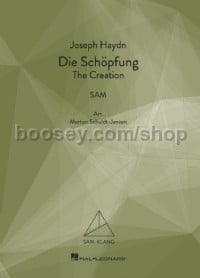Die Schöpfung/The Creation (Choral Vocal Score)
Die Schöpfung/The Creation (Choral Vocal Score)
Bulk Discounts Available
* Estimated price converted from UK retail price
Die Schöpfung is not only a decisive high point in Joseph Haydn’s career as a composer, but also marks a turning point in the history of the oratorio in general. On the threshold of the 19th century, Haydn broke with the traditional dominance of arias, gave the chorus much greater importance and thus paved the way for a new ‘chororatorio’ – one of the main pillars of the up-and-coming bourgeois concert life. Haydn was inspired to write Die Schöpfung on a trip to London in 1791 where he heard Handel’s Messiah and Israel in Egypt performed by the extraordinary forces of over 1,000 musicians in Westminster Abbey. The original libretto, which is based on the book of Genesis, John Milton’s Paradise Lost, and some of the psalms, was skilfully adapted and translated into German by the Imperial Court Librarian, Baron Gottfried van Swieten, who also translated it back into English – with perhaps more questionable results. Haydn began work on the oratorio in late 1796, and it was premiered in April 1798 to a rapturous reception. Haydn himself was almost overwhelmed with the performance, saying of it: “Sometimes my whole body was ice-cold; sometimes a burning heat overcame me, and more than once I was afraid I would suddenly have a stroke.” The work lost popularity during the Romantic period, where its perceived naïveties were less well received. However, affection for it grew during the 20th century and it now holds a secure place in the centre of the musical canon. The work is overwhelmingly optimistic (the fall of Adam and Eve is only mentioned once, and that in passing) and reflects the deep but accepting faith of Haydn described by one biographer as “not of the gloomy, always suffering sort, but rather cheerful and reconciled”. The musical writing demonstrates Haydn’s formidable technique, yet wears its learning lightly. The depiction of chaos in the overture is an extraordinary exercise in tone painting; the fugal movements which end each part are weighty enough, but never lose their drive; arias bubble with infectious energy. Haydn revels in writing for his subject, and it shines through in his music for both singer and audience.
Editorial note By its nature, this SAM-Klang edition occasionally challenges the performers with a somewhat higher level of activity than in the original SATB version, and in some places a slight redistribution of entries in the polyphonic sections has been made. Despite this, the original orchestral accompaniment can be used together with this version without restraint, and the work can also be performed with piano accompaniment.




